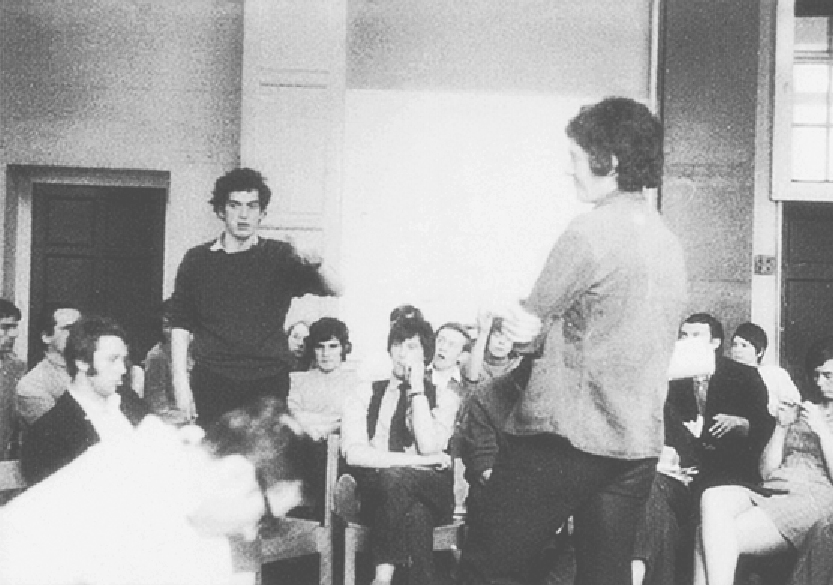R0370126@student.akbild.ac.at, "To the Knowledge Producers," in Intersections. At the Crossroads of the Production of Knowledge, Precarity, Subjugation and the Reconstruction of History, Display and De-Linking, ed. Lina Dokuzović, Eduard Freudmann, Peter Haselmayer, and Lisbeth Kovačič (Vienna: Löcker, 2008), 27.
Simon Sheikh, "Talk Value: Cultural Industry and Knowledge Economy," in On Knowledge Production: A Critical Reader in Contemporary Art, ed. Maria Hlavajova, Jill Winder, and Binna Choi (Utrecht: BAK, basis voor actuele kunst; Frankfurt am Main: Revolver, Archiv für aktuelle Kunst, 2008), 196-7.
Chris Wainwright, "The Importance of Artistic Research and its Contribution to 'New Knowdledge' in a Creative Europe," European League of Institutes of the Arts Strategy Paper (May 2008), →.
Michel Foucault, Discipline and Punish: The Birth of the Prison, trans. Alan Sheridan (New York: Vintage, [1975], 1995).
Lisa Tickner, Hornsey 1968: The Art School Revolution (London: Frances Lincoln, 2008), 13-14.
T.N., "Notes Towards the Definition of Anti-Culture," in The Hornsey Affair, ed. Students and staff of Hornsey College of Art (Harmondsworth, London: Penguin, 1969), 15.
Ibid., 29.
Ibid., 38-7.
Ibid., 116-7.
Ibid. [Document 46], 118.
See ibid. [Document 46], 122.
Ibid. [Document 46], 124.
Ibid. [Document 46], 128-129.
Angela Piccini, "An Historiographic Perspective on Practice as Research," PARIP (Practice as Research in Performance), →.
Ibid.
Ibid.
See Anna Pakes, "Original Embodied Knowledge: The Epistemology of the New in Dance Practice as Research," Research in Dance Education 4, no.2 (December 2003): 144
See Luc Boltanski and Laurent Thévenot, De la justification. Les économies de la grandeur (Paris: Gallimard, 1991); Luc Boltanski and Ève Chiapello, Le nouvel esprit du capitalisme (Paris: Gallimard, 1999).
See Hans-Jörg Rheinberger, Michael Hagner, and Bettina Wahrig-Schmidt, eds., Räume des Wissens: Repräsentation, Codierung, Spur (Berlin: Akademie Verlag, 1997).
See Caroline A. Jones, "The Server/User Mode: the Art of Olafur Eliasson," Artforum International 46, no.2 (October 2007): 316-324, 396, 402.
James Elkins, "Afterword: On Beyond Research and New Knowledge," in Thinking Through Art: Reflections on Art as Research, ed. Katy Macleod and Lin Holdridge (London/New York: Routledge, 2006), 243.
Ibid., 247.
Ibid., 246.
Irit Rogoff, "Turning," e-flux journal, no.0 (November 2008), ➝.
Elkins, "Afterword," 244.
Theodor W. Adorno, "Vers une musique informelle," in Gesammelte Schriften, vol. 16, (Frankfurt/Main: Suhrkamp, 1978), 493-540.
See Daniel Bell, The Coming of Post-Industrial Society (New York: Harper & Row, 1973).
See Jean-François Lyotard, La condition postmoderne: rapport sur le savoir (Paris: Minuit, 1979).
See Michael Gibbons et al., The New Production of Knowledge: The Dynamics of Science and Research in Contemporary Societies (London: Sage, 1994).
See Organisation for Economic Co-Operation and Development, The Knowledge-based Economy (Paris: Organisation for Economic Co-Operation and Development, 1996); "Putting Knowledge Into Practice: a Broad-Based Innovation Strategy for the EU," communication from the Commission to the Council, the European Parliament, the European Economic and Social Committee, and the Committee of the Regions (September 9, 2006).
Michel Foucault, L'Archéologie du savoir (Paris: Gallimard, 1969).
Nico Stehr, Wissenspolitik: Die Überwachung des Wissens (Frankfurt/Main: Suhrkamp, 2003), 30.
Antonio Negri and Michael Hardt, Multitude: War and Democracy in the Age of Empire (New York: Penguin, 2004), 126.
Yann Moulier-Boutang, Le capitalisme cognitif: La Nouvelle Grande Transformation (Paris: Éditions Amsterdam, 2007).
See Donna Haraway, "Situated Knowledges: The Science Question in Feminism and the Privilege pf Partial Perspective," Feminist Studies 14, no.3 (Autumn 1988): 575-599.
See Stehr, Wissenspolitik.
This essay is a revised and abridged version of a talk given at the conference “Art/Knowledge. Between Epistemology and Production Aesthetics” at the Academy of Fine Arts Vienna, November 11, 2008.
A Chinese translation of this text has been published in issue #4 of Contemporary Art & Investment.
本文的中文版发表在《当代艺术与投资》第四期上.
